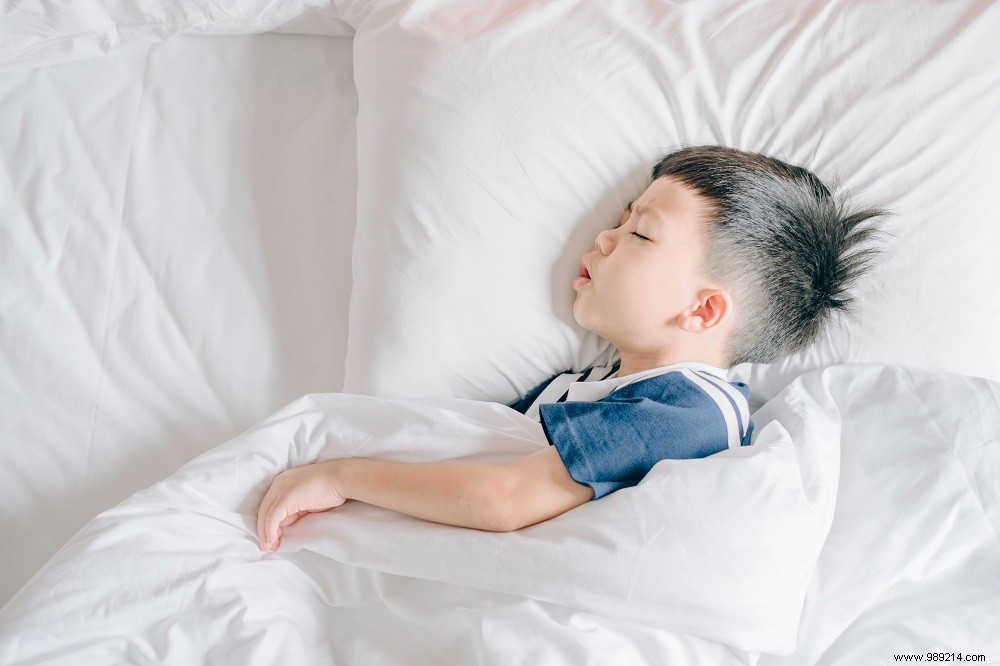
Diagnosed too late, obstructive sleep apnea syndrome (OSAS) in children concerns 1 to 3% of 3-6 year olds suffering from snoring. Untreated, this syndrome leads to a serious deterioration in the quality of life:restless nights, behavioral problems, school difficulties, and even cardiovascular and metabolic complications. If in doubt, do not hesitate to consult.
Does your youngest snore often, sleep with his mouth open, head back, sweat a lot at night and have frequent nocturnal awakenings? Maybe he has childhood obstructive sleep apnea syndrome (OSAS). If we often hear about this disorder in adults, it also sometimes affects the youngest. They too “may have partial or total obstruction of their upper airways (nose, throat) during sleep , explains Doctor Annick Andrieux, pneumo-pediatrician in Bordeaux, on the website of the Asthma and allergies association. The most at risk are children who were born prematurely, who have asthma, allergic rhinitis, repeated ENT infections, who have significant gastroesophageal reflux, and/or who have at least one parent who has sleep apnea. » This disorder is also more common in obesity. Still largely underestimated and diagnosed late, OSA in children concerns 1 to 3% of 3-6 year olds suffering from snoring according to the French National Authority for Health (HAS).
Respiratory efforts
If your child snores very occasionally but his night stays calm and he has no behavioral problems:don't worry. On the other hand, in the event of frequent snoring accompanied by respiratory efforts and sleep disturbances, do not hesitate to consult quickly. Untreated, OSAS leads to an alteration in the quality of life with a very agitated state during the day (anger, crying and sudden changes in mood), headaches, frequent breathing through the mouth, as well as attention and concentration difficulties. You can also more rarely find
“cardiovascular (high blood pressure) and metabolic (weight gain) complications” , says Dr. Andrieux.
Of multifactorial origin, OSAS is essentially "attributable to the hypertrophy of the pharyngeal soft tissues (vegetations, tonsils, editor's note), narrowness of the bony airways, impaired muscle tone or a combination of these factors" , details a study published online in May 2017 by the scientific journal Sleep Medicine.
Multidisciplinary support
For this reason, management must be multidisciplinary. Depending on the case, she may combine an ENT surgical treatment with removal of the adenoids, treatment by the orthodontist (breathing through the mouth can cause a growth disorder in the child's jaw), rehabilitation in maxillofacial or lingual physiotherapy (in children who breathe through the mouth, the tongue remains in a low position, that is to say it does not touch the palate). “Even if ENT care remains the mainstay ( the removal of the tonsils and adenoids eliminates all the symptoms in
80% of cases, editor's note), functional orthodontics and physiotherapy have an essential place in the overall care ” , underlines the Morphée health network, which specializes in sleep disorders. To all this are also added if necessary an allergological assessment as well as measures of hygiene of life, such as for example washing the nose of the child, adopting a balanced diet and regular physical activity. Finally, if sleep apnea persists following ENT surgery or if orthodontic treatment and maxillofacial physiotherapy last over time, a nasal mask with positive pressure ventilation machine (PPC or CPAP) may also be proposed.
A questionnaire to assess the severity of apnea in children
On its website, the Morphée health network offers a screening questionnaire for obstructive sleep apnea syndrome (OSAS) in 3 to 12 year olds, click here to consult it. This six-item questionnaire (breathing difficulties of the child during sleep, frequency and intensity of snoring, etc.), which is intended for parents, obviously does not replace medical advice. However, it sheds a first light. If in doubt, do not hesitate to consult your doctor.